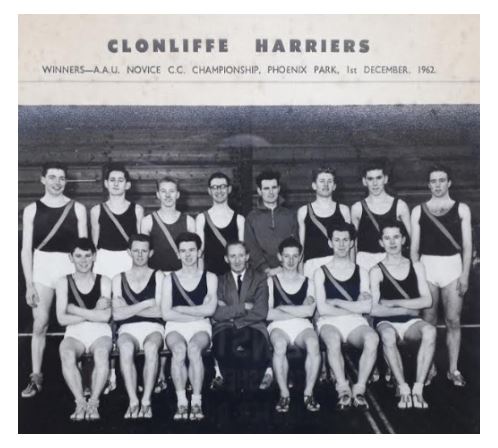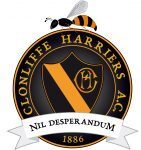Recently in a contribution to a ‘Harriers’ profile I wrote that I was always interested in Athletics amongst other sports. So thinking back I calculated that I attended many if not most of the Clonliffe Harriers sports at College Park, Lansdowne Road and Santry Stadium throughout the 1950’s. Inspired by the Rome Olympics of 1960 and the Clonliffe Harriers meeting that followed I made my way to the Stadium sometime after and joined the club. I have been asked under the heading ‘Memories’ to pen some of my memories of the sixties in and around Clonliffe. I do not intend it to be a historian’s view of club history from the newspaper archives but rather a “I was there” view of the hidden history matters.
In that 1st year, I listened carefully to the advice of the Captain Harry Cooney who in time became my Coach. Around then in 1961 the club celebrated 75 years of its existence, but the dressing room gossip left one in no doubt that all was not good in the club. Soon I was introduced to the annual pre-Christmas Toy run to Cappagh hospital and the unofficial run back 4.25 mile to the stadium. No mercy shown to newcomers, the senior members let the Novices know what stamina and strength was all about and whilst unofficial, the Captain added to his statistics for handicap purposes. Within a week, the Irish television service was launched and a few days later in January 1962 the very 1st recorded coverage of an Irish sports event was shown. Only portions of the Donore invitation 1 mile & 1000 yards from Chapelizod to the swing gates at Islandbridge. Clonliffe members were to the fore at the start and some were saying they should be in the 100 yards dash but sure they were only trying to stay up with the camera. The novelty of it all.
In a desperate bid for revenue, Billy Morton, our Hon Secretary used his contacts in England to entice four of the popular Rugby League clubs of the time to come to Dublin to play an end of season tournament. In May of 1962 whatever about media positivity the appearance of the four clubs Widnes, Warrington, Huddersfield and Featherstone Rovers was anything but a success and was counter productive to the club. Arising from this the honorary treasurer and trustee Michael McStay resigned and with no rush to take his position Billy took on this Hon position also. Some weeks later the gossip of the time became a reality when headlines in the sport pages of the Irish press read of Clonliffes difficulties. Four years after the opening of the stadium the creditors were still due almost £20,000. The failure of the Military Tattoo of 1959 and the rugby League tournament had not helped, and questions were asked about what was going wrong with Athletic attendances.
All sorts of reasons were common among members with some jocosely blaming the ranting of Myles na Gcopaleen in the newspapers, others blamed the curse of the Domvilles and their bad luck. They were residents for over 200 years of the great Big house of Santry. Even some said it was the “Revenge of the Fairies” in reference to the clearing of the woods and the long-standing shrubbery where the stadium now stands. Much more likely the advent of TV and the availability of world class athletics in front of 35,000 at the White City. Furthermore, the winning after 16 years of the All Ireland football final by a native Dublin team in 1958 and with most of the team being Northsiders GAA became the sport that was attracting attendances locally.
The cards were truly on the table now and the pressure was particularly on the Officers/Trustees. The meagre club finances could pay for the maintenance of the track, top dressing etc and also the fuel for the boiler house and whatever else. Billy Morton undertook to pay the groundsman wages on a week by week basis which in the end lasted years. However, there was no money to pay for prizes or team entry fees and travel costs were always paid by the athletes themselves.
To support this need, an ad hoc committee “checkmates” was formed of Olaf Rafferty, Alex Sweeney, Al Guy, Johnny O’Leary, Don Appleby and Maurice Ahern. They worked hard for possible money making ventures and they were helped and supported by many others over the following years. Far from today’s super website Alex Sweeney produced the Clonliffe news sheet as editor and printer. I must dust off the copies I have in my attic and read the articles of interest as contributed by the editor and members in those far off days. After training I sold Slainte minerals and club milks to the members helped by Johnny O’Leary. Don Appleby in whose home the more important meetings were held was the chief organiser of the Seven-a-side football tournament and Al Guy promoted the flag days.
Of course, there was crossover help for all of the aforementioned while they lasted and some making money for years. I well remember my young brother Bertie as a 14 year old standing outside the “Payantake” grocery shop on the Drumcondra Road shaking his yellow flag box “S.S.S” Save Santry Stadium. The returns from the annual flag days went to the stadium fund.
The Irish Tennis people and the agents for the track encouraged Clonliffe to lay an all weather tennis court inside the track but after a few professional tournaments there Billy was disillusioned when the plum match which all tennis wanted to see between Pancho Gonzalez & Lew Hoad became a 5 set thriller before a huge audience at Lad Lane, the home of Fitzwilliam in 1961. Clonliffe needed to use the facility and so the tennis court was lifted and replaced with grass and Home Farm became the 1st club to use it.
There were many other clubs after that and right up to the present day. Athletics and athletic chat was not forgotten, Jesse Owens visited Dublin and spoke at a sports conference in the S.F.X. Brian Kilby of Coventry Godiva set a new record distance for a 1 hour track run and later in September we had a festival of sport in the stadium.
The AGM carried by 1 vote a proposal to increase the sub to £2. Harry Cooney the Captain despite the obvious pressure never forgot the athletes making the same journey, first by bus and later by car from Crumlin to the stadium three days a week. After a discussion with the novice panel members, it was agreed that if the club was open at night Monday through to Thursday and at the weekend an all-out effort would be made to win the novice team title, this was achieved in December 1962 but was to be the clubs last team gold on road or cross country until 1968.

Athletes seeking a change of club knew they had to make a decision, join a famous club with its own track for training or another unburdened by debt. Young stars of the future like Frank Murphy and Des McCormack were welcomed to Santry in what was to become a snow laden cross-country season.
1963 opened with the annual match between Clonliffe Harriers & London University on the XC and then a further headache what to do about the deadline of the land option we had on other ground surrounding the stadium. Meanwhile the monthly fundraising dances at the O’Lehane Hall in Parnell Square got underway with dances in March/April/May and later in the year at the St.Anthony Hall. One cynical member using the club news sheet wrote a snarling article demeaning the effort of the main committee as they threaded their way between legal letters, finance and athletics. Perhaps the naming of the stadium as the John F. Kennedy stadium was not thought out fully at the time. The USA President passed the gate in June of that year.
The Douglas Wilson Road Relays continued as did an International meeting at Santry though the by passing of Clonliffe Harriers who were more synonymous with International Athletics meetings for the showing of Ireland’s 1st live Athletics on TV was disappointing. This Civil Service AC meeting was held on the grass track in College Park in July 1963. Frances Mansfield’s memory of the Ladies section in 1963 and there after is detailed and so in remembering the great fun we had in those years I will leave it with Frances. Just two more memories I have of the end of 1963, I was elected to the club committee in October of that year for the 1st time and the trial race on the track at the end of November. The prize, a trip to Kenya for the winner Basil Clifford and the distance 1 mile.
Part 2 of Maurice’s Memories next week.
